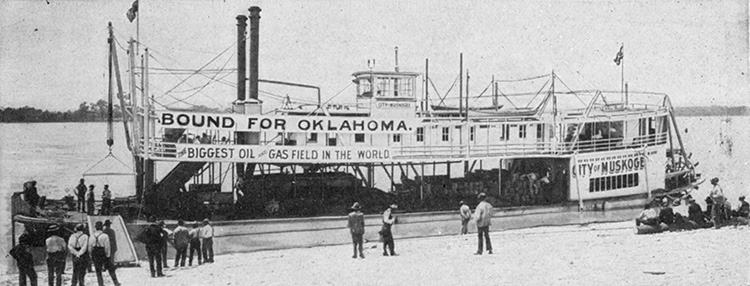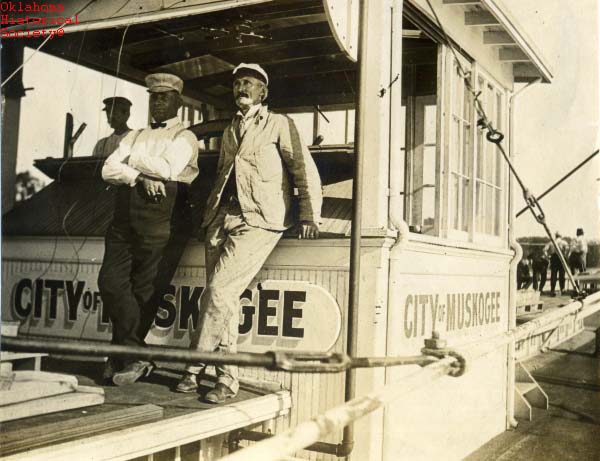
The Encyclopedia of Oklahoma History and Culture
STEAMBOATS AND LANDINGS.
From the early 1800s to the early twentieth century, steamboats were a major catalyst to the opening of the American West. Possessing the ability to deliver goods inexpensively and swiftly to the frontier, steamboats fueled the economy and led to the establishment of plantations, farms, towns, and cities.
Several factors were involved in the development of steam navigation in Oklahoma. With establishment during the 1820s of Fort Gibson on the Arkansas and Fort Towson on the Red River came the daunting task of supplying them by wagon. During the next decade the removal of the Five Tribes from the southeastern United States to Oklahoma demonstrated the need to provide the tribes with goods promised by treaty. Just as importantly, cotton culture was expanding into the Old Southwest, which promised to be the premier cotton-growing region of the world.
Clearly, the development of navigation on Oklahoma rivers offered distinct advantages. In 1824 the steamboat Florence ascended the Arkansas River to Fort Gibson to deliver new army recruits. Later, dozens of other steamboats arrived at the Fort Gibson Landing carrying soldiers, American Indian immigrants, military provisions, and trade goods. Major exports from the area included cotton, hides, and pecans.
In 1831 Ben Milam, who a few years later would become a hero of the Texas Revolution, conducted the first steamboat voyage to the Upper Red River above Shreveport, Louisiana. He took the steamboat Enterprise through the swamps and bayous that then made up much of Red River to deliver supplies to Fort Towson.
Practical navigation on the Upper Red River was delayed until the removal of the Great Raft, a logjam extending from below modern Shreveport to the Arkansas-Louisiana line. In 1833 Henry Miller Shreve began demolition of the Raft, a task initially completed in 1838 and not fully finished until the turn of the century. With the Red River open intermittently, hundreds of steamboats plied the stream as far as Preston Bend south of present Kingston, Oklahoma. The ability to ship downstream made cotton production a major industry for the Choctaw and Chickasaw of Oklahoma, as well as for farmers and planters in northeast Texas and southwest Arkansas.
Navigation on the Arkansas and Red rivers was difficult and dangerous due to snags and frequent low water. Boats often attempted to go upstream almost year round, but the usual "boating season" ran from January to June. Although seasonal, high freight rates made steamboat operations on these streams economically attractive.
Most steamboats plying the rivers of Oklahoma were based in the Ohio River Valley as far east as Pittsburgh, Pennsylvania. Others hailed from New Orleans and Shreveport, Louisiana. The Ohio River system provided access to manufactured goods from the East, and New Orleans served as an international seaport from which cotton was shipped to the textile mills of New England and Great Britain.
Major river towns had "levees," that is, graded inclines for steamboat docking. For the most part, however, a "landing" was simply anywhere near a plantation or small town where a steamboat could pull up and lay a stage plank to the shore. Some of the landings on the Arkansas River included Fort Coffee, Skullyville, Sallisaw, Webbers Falls, and Fort Gibson, the head of navigation. There were thirty-two landings on the upper Red River, with Fort Towson (also called the "Public Landing") being the most significant. Other landings associated with Oklahoma were Pecan Point, Jonesborough, Kiamichi, Colbert's Ferry, and Preston Bend.
With the expansion of railroads during the later decades of the 1800s, steamboat operations began to dwindle. Offering safe, reliable, and inexpensive transportation to and from points far from the limitations imposed by rivers, railroads eventually supplanted the steamboat. Nevertheless, small short-haul steamboats operated on the rivers of Oklahoma into the early decades of the twentieth century.
See Also
COLBERT'S FERRY, FERRIES AND FORDS, HEROINE, RED RIVER RAFT, TRANSPORTATION







